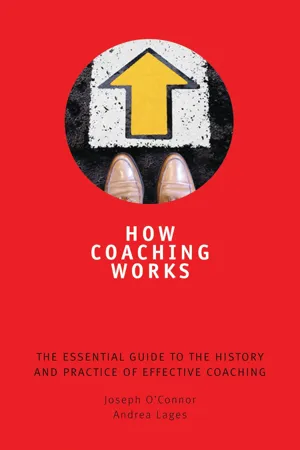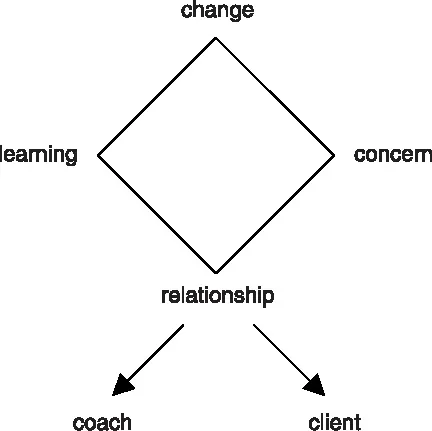![]()
PART ONE
![]()
1 COACHING ON THE EDGE OF CHAOS
‘If we treat people as they are, we make them worse. If we treat them as they ought to be, we help them to become what they are capable of becoming.’
Goethe
In 2004 we gave our first coaching course in Santiago, Chile. The group consisted mostly of managers, who were keen and attentive. A weak sun shone through the white curtains that covered windows of the Radisson Hotel, and outside, the Andes that form such a wonderful backdrop to the city were struggling to assert themselves through a polluted autumn mist. On the first morning of the course, we gave an overview and short history of coaching. ‘Coaching,’ we began, ‘comes from an old Anglo-Saxon word for a carriage, something that takes you from where you are to where you want to be.’ A hand went up in the group; someone wanted to comment.
‘It also comes from the old French word “coche”, meaning a carriage,’ said François, a participant who was to become a good friend. The temptation for Joseph to fight for the historical pride of England against the French was tremendous, but he managed to resist. We thanked François for this extra piece of new information. Later, as we further researched the origin of the word ‘coaching’, we discovered something even more interesting.
There was a town called Kocs in medieval Hungary, near the walled town of Komárom. It held a strategic position in the transport network and was the Heathrow airport of its day. Many carriages stopped at Kocs on their way through central Europe and, because of its position, it was a lively trading centre. Not surprisingly, it started to make carriages. During the 15th century, the wheelwrights of the town began to build a horse-drawn vehicle with a steel spring suspension. This‘kocsi szeker’, as the Hungarians called it, or ‘cart of Kocs’, very soon became popular all over Europe. It was the business-class way to travel through central Europe, comfortable and stylish. Soon these carriages were known by the name of the town that made them. A ‘kocs’ was a superior carriage, an elegant way to make a journey in quick time. This is the origin of the word ‘coach’, and similar words appeared in most European languages. Both Joseph and François were right and we discovered a great metaphor, because coaching is not just a way to reach your destination, but also the best and most elegant way to travel.
WHAT IS COACHING?
Let’s start with this question, before looking at how coaching works. Coaching is a form of consultation to help the client. There are three main forms of a helping consultation based on how much responsibility the client has in the process.
First, there is the expert model, where the client buys expertise and has no responsibility for the outcome. For example, you buy the services of an architect to design your house and project-manage the construction. He does all the work, hiring the builders and decorators. You pay the bills and then you live in your house.
Second, there is the medical model of doctor and patient, where the client has a limited responsibility. Usually this is to take any prescribed medicine and follow instructions.
Third, there is the process consultation model, where the client has complete responsibility. Process consultation is defined as ‘The creation of a relationship with the client that permits the client to perceive, understand and act on the process events that occur in the client’s internal and external environment, in order to improve the situation defined in the problem’(1). This is an excellent definition of coaching, because it deals with relationship and process. Coaching is a form of process consultation(2) where the coach’s main task is to help clients understand their way of generating problems, not to solve them.
Coaching is a means to an end, to help people lead a full and satisfying life, and has many possible definitions. To get the most comprehensive view of coaching, we need to take a number of perspectives. There is a broad consensus in the many books and schools of coaching, with the following being some typical definitions:
‘. . . Sustained cognitive, emotional and behavioural changes that facilitate goal attainment and performance enhancement in one’s work or in one’s personal life’ (3).
‘. . . The art of facilitating the performance, learning and development of another’ (4).
‘. . . Equipping people with the tools, knowledge and opportunities they need to develop themselves and become more effective’ (5).
‘. . . Coaching is unlocking a person’s potential to maximize their own performance. It is helping them to learn rather than teaching them’ (6).
‘. . . Coaching is a powerful relationship for people making important changes in their lives’ (7).
‘. . . Helping a person change in the way they wish and helping them go in the direction they want to go. Coaching supports a person at every level in becoming who they want to be and being the best they can be’ (8).
‘. . . Coaching is about learning. . . the coach and coachee enter into a learning partnership together’ (9).
There are many more definitions like these. They are pointers to help you look in the right direction; they give clues, not answers. What are they pointing at? What can we take from these definitions? They are all abstract, because they are taken out of context, but they show a common idea, a basic architecture of coaching. These definitions contain four important elements in coaching – change, concern, relationship and learning. We will take a brief look at each in turn.
The basic architecture of coaching
CHANGE
Change implies direction and development, moving towards something better, either because you do not like what you have, or because you are attracted towards something better. Clients may seek change or have it forced upon them. Either way, they need to manage it in the best way. They may not know how to do this or have tried and failed. What needs to change in the client to deal with an outward change of circumstances? Thinking, emotions and behaviour.
CONCERN
Second, clients have a concern; some imbalance in their life, a problem, issue or goal they want to achieve. Life has made a demand that their current habits of thinking, feeling and behaviour cannot meet satisfactorily. They are not where they want to be and it bothers them. Many clients are not at all clear where they want to be, but they know very well they are not there yet.
You cannot separate the concern from the person who has it.
Thirdly, coaching creates a powerful relationship – a partnership. Every client is unique, and the coach needs to treat him or her as such. The relationship needs to be one of trust, and the quality of the relationship coach and client create together is a determinant of how successful the coaching will be.
Coaches deal with clients, not problems.
LEARNING
The fourth support is learning. Coaching helps clients learn and to become better learners in two different ways: first, learning a particular skill, or how to solve a particular problem; second, learning how to learn, how to be a problem solver. Coaching fosters the capacity for self-directed learning and personal growth as well as helping clients to solve problems, make decisions or achieve goals. Unless clients become learners and look at the world with new eyes, they will always be dependent on someone else for guidance, whether it be parent, teacher, boss or coach. Clients need to be able to generalize from a problem; they need not just to solve the problem that is confronting them, but to look critically at their thinking that gave rise to the problem in the first place. We shall discuss both types of learning in depth later in the book.
THE COACH AND CLIENT
Coaching does not happen without people; coach and client must be included in any definition of coaching. The coaching process is created moment by moment as they work together. Shared expectations are crucial. For example, if clients demand that the coach tells them what to do and threaten to leave if the coach does not comply, then clearly coaching cannot happen. Similarly, the coach should behave like a coach, and not tell clients what to do or give them solutions. A coach also needs to have certain supporting beliefs and values to help clie...








